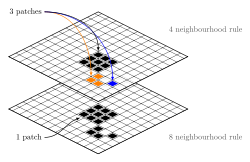| PGF/TikZ ("PGF and TikZ") | |
|---|---|
 Example of graphics created with TikZ | |
| Original author | Till Tantau |
| Developers | Till Tantau, Christian Feuersänger |
| Stable release | 3.1.11 [1] / 14 August 2025 |
| Repository | |
| Written in | TeX, Lua |
| Operating system | Multiplatform (TeX) |
| Type | Vector graphics languages |
| License | Dual license: GNU General Public License or LaTeX Project Public License |
| Website | tikz |
PGF/TikZ is a pair of languages for producing vector graphics (e.g., technical illustrations and drawings) from a geometric/algebraic description, with standard features including the drawing of points, lines, arrows, paths, circles, ellipses and polygons. PGF is a lower-level language, while TikZ is a set of higher-level macros that use PGF. The top-level PGF and TikZ commands are invoked as TeX macros, but in contrast with PSTricks, the PGF/TikZ graphics themselves are described in a language that resembles MetaPost. Till Tantau is the designer of the PGF and TikZ languages. He is also the main developer of the only known interpreter for PGF and TikZ, which is written in TeX. PGF is an acronym for "Portable Graphics Format". TikZ was introduced in version 0.95 of PGF, and it is a recursive acronym for "TikZ ist kein Zeichenprogramm" (German for "TikZ is not a drawing program").















